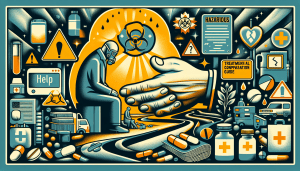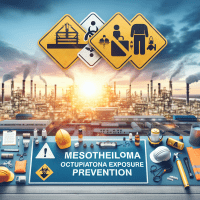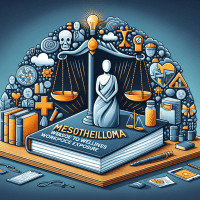Mesothelioma Workplace Exposure Prevention Guide
Hi, I’m Jane Smith, R.N., with 15 years of oncology experience, and I’ve navigated the challenges of mesothelioma personally and professionally. When I first encountered the reality of mesothelioma workplace exposure, it felt like the ground shifted beneath my feet. I know the turmoil and the overwhelming uncertainty that comes with it, and I am here to offer support, clear information, and actionable steps to help you and your loved ones protect yourselves. In this guide, I share everything from practical preventive measures and detailed explanations of diagnosis steps, to heartfelt coping strategies. I want you to know that you are not alone on this journey.


Understanding Mesothelioma and Workplace Exposure
Mesothelioma is a rare and aggressive cancer predominantly linked to exposure to asbestos in the workplace. The disease attacks the protective lining of the lungs, abdomen, or heart, and it often goes undetected until advanced stages. The primary risk is exposure, which might occur over years of working in environments where asbestos fibers are present. I learned early on that prevention is key – both in minimizing exposure and in knowing when to seek help.
The Impact of Workplace Exposure
When we discuss mesothelioma, understanding the role of workplace exposure is crucial. Asbestos fibers, once inhaled or ingested, can lodge in the pleura and trigger inflammatory responses leading to cancer. Many individuals feel overwhelmed by this risk. I have heard and experienced the same fears of not only dealing with a diagnosis but also the guilt of having been exposed unknowingly. This guide is written from my heart to help demystify the process and provide you with effective preventive measures.
Practical Steps for Mesothelioma Workplace Exposure Prevention
Prevention starts with awareness and proactive measures. Whether you’re an employee, a contractor, or a concerned family member, here are concrete steps you can take to reduce the risk of asbestos exposure:
- Risk Assessment: Request a thorough assessment of your workplace to identify potential asbestos-containing materials.
- Workplace Safety Equipment: Use certified protective gear such as respirators and coveralls, and ensure that safety protocols are rigorously followed.
- Regular Training: Participate in training sessions on handling hazardous materials and stay updated on the latest preventive measures.
- Maintenance and Abatement: Encourage management to organize regular inspections and implement asbestos abatement services when necessary. Look for certified asbestos abatement companies near you.
- Policy and Compliance: Ensure that your employer complies with OSHA standards in hazardous work environments. Strong policies and adherence can significantly reduce exposure risks.
Integrating these practices into daily routines can help lower the risk of mesothelioma. I have seen firsthand how vigilance and proactive intervention not only protect us but also promote a culture of safety and care in the workplace.
Diagnosis and Staging: What to Expect
Understanding your diagnosis can be daunting, but knowledge is power. Here’s a brief overview of what might happen if exposure leads to mesothelioma:
Types of Biopsies and Diagnostic Tests
When symptoms such as persistent chest pain or shortness of breath occur, doctors may recommend several diagnostic tests, including:
- Thoracoscopy: A minimally invasive procedure where a small camera is inserted to examine the pleura.
- Thoracentesis: A procedure to drain and test fluid from around the lungs.
These procedures help in confirming a diagnosis and determining the stage of the cancer.
Mesothelioma Staging Simplified
The mesothelioma staging system is generally divided into four stages:
| Stage | Description |
|---|---|
| Stage 1 | Localized; cancer is confined to the area of origin, offering the best treatment outcomes. |
| Stage 2 | Spread to nearby tissues; treatment plans become more aggressive and integrated. |
| Stage 3 | Spread over larger areas; treatment focuses on symptom management and quality of life. |
| Stage 4 | Advanced; cancer has spread to distant tissues and organs, requiring comprehensive care. |
Understanding these stages can empower you to have more informed discussions with your medical team about treatment options and expected outcomes.
Treatment Options: A Guided Overview
When it comes to treating mesothelioma, each case is unique and often requires a multimodal approach. Many trusted treatments include:
- Surgery: Procedures to remove tumors, often employed in the early stages.
- Chemotherapy: Drug treatments that aim to shrink tumors or slow their progression.
- Radiation Therapy: Targeted radiation used to control or reduce tumor size.
- Immunotherapy: Employing drugs such as Nivolumab/Ipilimumab to boost the body’s immune response against cancer cells.
- Multimodal Therapy: A combination of treatments tailored to the patient’s specific stage and condition.
It is essential to discuss these options with mesothelioma specialists who can guide you based on your specific diagnosis. Always consider consulting multiple experts to find the most suitable treatment plan for you.
Your First 30 Days: A Step-by-Step Guide
Early days after a diagnosis can be overwhelming. I have put together a step-by-step guide to help you navigate the first 30 days:
- Confirm the Diagnosis: Get a second opinion, discuss biopsy results, and understand the staging of the cancer.
- Research Specialists: Look for mesothelioma specialists or NCI-designated cancer centers to guide your treatment.
- Assemble Your Support Team: Include family, close friends, and professional counselors. Reach out to online patient support groups.
- Organize Medical Information: Keep records of all reports, treatments, and appointments.
- Plan Ahead: Consider your work, finances, and transportation. I highly suggest creating a checklist, which I have detailed below, to help manage the overwhelming details.
- Questions to Ask Your Oncologist Checklist:
- What exactly does my staging indicate?
- What treatment options are recommended for my stage?
- What are the potential side effects?
- How can I improve my quality of life during treatment?
- Who can I contact for additional support?
- Questions to Ask Your Oncologist Checklist:
This checklist is designed to ensure you leave no crucial question unasked. I encourage you to print out or note these down so you can refer to them during your appointments.
Coping with the Emotional Waves: My Personal Reflections
Emotionally, being diagnosed with mesothelioma can be as challenging as understanding the medical complexities. I know many have felt isolated and overwhelmed by anxiety, fear, and grief. Here are some strategies that have helped me and others:
- Open Communication: Talk to your loved ones honestly about your feelings. It’s okay to show vulnerability.
- Seek Professional Counseling: Mental health support is crucial. Consider joining support groups where shared experiences build strength.
- Mindfulness and Self-Care: Engage in mindfulness exercises, journaling, or light physical activities that cultivate calm and centeredness.
- Stay Connected: Connect with others who understand. I often say, “From my heart to yours, never hesitate to ask for help.”
A Personal Reflection: “When I first heard the diagnosis, I felt utterly alone. But connecting with others, sharing my fears and hopes, gave me the strength to face each day with a renewed sense of purpose.”
Additional Resources and Transparent Support
For those of you facing workplace exposure concerns, remember that knowledge is your best defense. Additionally, MesoGuideCenter is a free resource supported by our network of mesothelioma law firms. We connect patients with experienced legal and medical professionals. This funding allows us to provide comprehensive information and support at no cost to you. It is important to utilize all available resources, be they medical, legal, or community-based, to provide the best possible care and guidance.
If you’re looking for further information or similar experiences, I encourage you to visit related articles on our site, such as our detailed discussion on Mesothelioma Treatment Options or our guide on Support Groups and Community Resources. These resources offer additional strategies that have helped others navigate their journey through mesothelioma.
Next Steps and Final Words of Encouragement
As you move forward, remember that every step you take towards understanding and preventing mesothelioma workplace exposure counts. With informed decisions and proactive measures, you can reduce risks and better manage any challenges that arise. I encourage you to:
- Discuss any concerns openly with your healthcare team.
- Utilize the checklist provided in this guide for your appointments and follow-ups.
- Consider reaching out to a mental health professional to support both you and your caregivers.
- Engage with local support groups and online forums where others share similar experiences.
Remember, you are not defined by your diagnosis. Each day brings an opportunity to learn, grow, and connect with others who truly understand your journey. I am here with you, sharing not only my expertise but also my heart, as we navigate this path together.
Information on treatment guidelines current as of May 2025.
Schema Markup Suggestions
For improved SERP visibility, consider implementing medical condition and FAQ schema markup. This ensures that search engines understand the valuable content and compassion behind each portion of this guide.






